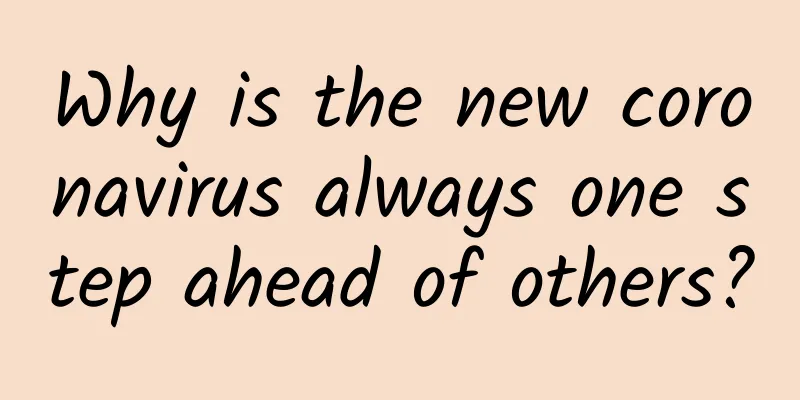Why is the new coronavirus always one step ahead of others?

|
As long as there are susceptible people, the virus will evolve. The C.1 lineage of the coronavirus that first appeared in South Africa in January 2021 looked similar to other variants at the time, and it had not spread too widely, and there was nothing strange about its genome. However, the virus evolved abnormally fast, faster than any other organism on Earth. Ed Feil, a professor at the University of Bath in the United States who studies pathogen evolution, recently analyzed the mutation rate of the new coronavirus and found that "the number of mutations that SARS-Co V-2 has experienced during the pandemic is the same as the number of mutations that humans have experienced from the first time they walked upright 2.5 million years ago to today." Just four months after the C.1 lineage appeared, South Africa encountered a third wave of COVID-19 caused by the highly transmissible Delta variant, and a team tracking the strain detected a large number of changes in the new version of the C.1 genome. They soon discovered that the new version was the C.1.2 variant, which had more mutations than other variants - key mutations possessed by alpha, beta, gamma and delta variants, as well as some mutations related to immune escape, all appeared in it. The new variant is already 40% to 60% more transmissible than the Alpha variant, which was already 50% more contagious than the original strain, turning into what some epidemiologists call "the most contagious disease we've ever seen in our lifetime." The viruses that cause measles and chickenpox are more transmissible than the Delta variant, but the latter spreads extremely quickly, traveling from host A to host B in four days, while other viruses take at least 10 to 14 days. The COVID-19 factory is open in the human body. As long as there are susceptible people, the virus will spread, replicate and mutate. The evolution of life under natural selection is a law of biology, just as gravity is a law of physics. The continued spread of the new coronavirus will lead to further mutations, the emergence of new variants, leading to more deaths and a continued pandemic. Humanity is certainly working hard to try to control the evolution of the coronavirus. Every day, vaccine manufacturers, researchers, and governments are tracking changes in the virus, identifying and controlling new variants, and trying to slow its spread. We have launched the largest vaccination campaign in history—3.9 billion people have received at least one dose of a coronavirus vaccine in the two years since the outbreak began. However, humans have not been able to control the new coronavirus so far. SARS-Co V-2 can be said to be a model of life evolving under natural selection, which puts us in danger if we underestimate the power of nature - as we have experienced countless times in the past and will continue to experience in the future. The SARS-Co V-2 genome consists of 30,000 bases, which store instructions for proteins that are responsible for hijacking our cells and producing billions of new viruses. When a person inhales SARS-Co V-2, the spike proteins on the surface of the virus recognize and attach to proteins on human cells. Although the infection process begins in the throat and lungs, SARS-Co V-2 eventually attacks systems throughout the body, including the heart, blood vessels, intestines, and kidneys. After attaching to a host cell, the virus injects its genome, a single strand of 30,000 RNA bases, into the cell. There, viral proteins begin to reshape the cell's structure to accommodate its massive proliferation. The SARS-Co V-2 genome is like the architect and general manager of a factory, leading and coordinating the work of all parties to produce more viruses. A lot of mutations, a few survive Each new virus particle carries a newly replicated copy of the RNA genome and is ready to infect more cells. When they leave the host cell, they trigger a chain of events that kill the latter. As the cell dies, it releases signals to the immune system, alerting the body to the danger. In some cases, the resulting immune response to these signals - including severe lung damage or cytokine storms - does more harm than good. During RNA replication (the aforementioned duplication of a copy of the genome), errors can occur, such as bases being replaced or a small section of RNA being added or deleted from the original sequence. These random mutations are often subtle, but can have serious consequences. We usually think of mutations as bad for an organism, such as mutations in the hemoglobin gene that cause sickle cell disease. But mutations can also be neutral or even beneficial, such as mutations in a gene related to insulin production that make people 65% less likely to develop diabetes—even if they have risk factors such as obesity. Every time a virus infects a new host and produces new copies, it can acquire new mutations, good or bad. In June 2021, a research team at the Weizmann Institute of Science in Israel worked with other units to carry out calculations and found that every time a human is infected with SARS-Co V-2, the body produces 1 billion to 100 billion copies of the virus. They also estimated that during each infection, 0.1 to 1 mutation may occur in the viral genome - if we conservatively set the number of new mutations to 0.1, then the 425,000 new cases per day worldwide will bring 42,500 mutations, which means that every 30,000 bases in the SARS-Co V-2 genome may mutate every day. Fortunately, few of these mutations take hold, because because of the bottleneck of transmission, mutations that occur during one infection rarely make it to another host. According to two recent studies, the small amount of virus that spreads to others is often the same strain that infected them in the first place. In the words of Vaughn Cooper, a microbiologist at the University of Pittsburgh, “What goes in is often what goes out.” Unfortunately, there is an exception. If the virus stays in an individual for a long time (for example, an individual with a weak immune system that cannot clear the virus), it will interact extensively with the human immune system and acquire useful mutations to fight immunity. For example, over the past year, scientists have observed that SARS-Co V-2 variants have acquired mutations that are sufficient to change the shape of the spike protein, making it difficult for protective antibodies to target it. (Antibodies bind to the spike protein like a key in a lock, neutralizing the virus.) As the virus roams through the host, the new mutations replicate to the point where they are ubiquitous and can be passed on to other people, bypassing transmission bottlenecks. There is evidence that the alpha variant may first appear in immunocompromised individuals, and Cathrine Scheepers, a computational biologist at the National Institute for Communicable Diseases (NICD) in South Africa, believes the same is true for C.1.2. Of course, most mutations that accumulate in a single infection are lost in the bottleneck of transmission, but some slip through the net. The virus spreads so quickly that the low-probability event often happens that the strain acquires and passes on mutations… Any adaptive mutation that confers a competitive advantage to the virus to survive and reproduce in its environment is more likely to be passed on and become a permanent part of the genome. This is how natural selection works. The single-site mutation D614G accelerates its spread. Today, SARS-Co V-2 acquires about 2 permanent mutations per month as it circulates among the global population. The epidemic is far from over. On January 5, 2020, Professor Zhang Yongzhen, a virologist at the Shanghai Public Health Clinical Center affiliated to Fudan University, uploaded the first SARS-Co V-2 genome sequence to a public database, attracting global attention. As of late October 2021, the coronavirus sequence released by China has been shared more than 4.7 million times on the free genome sharing platform GISAID database (launched in 2008 for influenza). Millions of shared genome sequences have enabled scientists to track viral mutations in near real time, a first in human history. After building a system to detect mutations, scientists began to pinpoint their role in puzzling molecular detail. D614G (sometimes called "Doug") was the first major mutation in SARS-Co V-2 and one of the mutations that accelerated the virus's spread around the world. In early April 2020, Doug started to attack from the UK and spread to the world. Researchers found that once the D614G variant is introduced into a certain area, it will quickly become the most common strain there. The mutation itself is that the 23,403rd base A in the viral genome is replaced by G, resulting in the aspartic acid in the spike protein being changed to glycine. This change makes it easier for the virus receptor binding domain (the segment that connects to human cells) to lock onto host cells. After D614G, a series of adaptive mutations of the new coronavirus appeared before our eyes in the form of strings of codes: P681R, L452R, D950N, del144Y, K417N, T1027I, A701V, N501Y, L18F, del242-244... Studies have shown that mutations in SARS-Co V-2 increase the virus's ability to spread and its resistance to antibodies, and also increase the severity of infection symptoms. Genome recombination and convergent evolution Although single-point mutations like Doug have a significant impact on the adaptability of the virus, scientists believe that the combination of mutations is the main force that makes the variants stronger, especially Delta, whose spike protein has accumulated 9 mutations, making it more transmissible. In addition, RNA viruses have another way to evolve rapidly, which is genetic recombination - multiple viral RNAs in the same cell exchange nucleotide sequences. According to some epidemiologists, it is possible (even likely) that the various variants currently spreading can become so-called "super variants" through genetic recombination. However, although we have indeed discovered some recombination phenomena, at present, they are still low-probability events. There is also some good news. In the past 20 months, scientists have discovered clues to the evolution of the virus. Natural selection is pushing the virus towards enhanced transmission and immune escape, but it does not necessarily cause more severe symptoms in humans. Cooper said that severe diseases such as cytokine storms are byproducts of infection and do not seem to help the virus spread or proliferate better, so this characteristic will not be selected. On the other hand, Trevor Bedford and Katie Kistler of the Seattle Cancer Research Center recently used the GISAID database to find that the most successful virus lineages have acquired spike protein mutations associated with enhanced ability to enter host cells, as well as mutations in the Nsp6 protein and ORF7a protein (which are associated with viral replication and evasion of the innate immune system, respectively). Such mutations appear in different strains in different parts of the world, a phenomenon we call convergent evolution. If SARS-Co V-2 converges on certain key adaptations, it will become more predictable, which may help scientists track the virus and develop vaccines. Cooper said: "The good news is that we haven't seen completely new combinations, and hopefully that will calm people down." Infection drives evolution, vaccines protect against infection and accelerate clearance. Trying to guess the next dominant mutation is a fool's errand, but stopping viral evolution is an important task that vaccine manufacturers and governments around the world are actively pursuing. Kistler said the only way to slow the evolution of the virus and prevent the accompanying mutations and the emergence of new variants is to delay the spread of the virus, "every infection is an opportunity for the virus to evolve further." The most powerful weapon humans have to slow the spread of COVID-19 is vaccination. Different vaccines protect the body from invaders in different ways, but the common pattern is that vaccines put inactivated viruses or virus fragments (non-infectious) in front of the recipient's immune system, simulating a virus invasion scenario and training the body's defense capabilities. The benefits of vaccination extend beyond prevention. If a vaccinated person becomes infected, they tend to produce less virus in their bodies and are usually able to clear the pathogen faster than an unvaccinated person, reducing the time it takes for the virus to mutate. Immune escape and vaccine rehearsal Doctors or scientists talk about so-called "escape" variants that can avoid immune protection from vaccines or infections. For example, mutations carried by the beta variant, including E484K (also called "Eek"), allow it to evade the immune system to a certain extent because its spike protein is less easily bound by antibodies. As early as February 2021, clinical trials showed that the AstraZeneca vaccine could not prevent mild to moderate new coronavirus caused by the beta variant. South Africa even stopped using the vaccine. The spread of the delta variant also seems to be affected by similar mutations. Currently, vaccine companies have stated that the vaccines they have launched are the best protection against all known variants, and most vaccine companies also encourage high-risk groups to receive booster shots. In addition, Pfizer, Moderna, and AstraZeneca have been conducting "dress rehearsals" for known new crown variants in the past few months, including updating vaccines to match variants such as Beta and Delta, testing updated vaccines, adjusting internal work processes, and coordinating with regulators, etc., aiming to "practice makes perfect" through "drills" and eliminate obstacles in the process of vaccine launch. "When we see a variant that can really escape immunity, we can take quick action immediately," said Philip Dormitzer, vice president and chief scientific officer of viral vaccines at Pfizer Vaccine Research and Development. Pfizer spokesman Kit Longley said that no matter what new variant emerges, Pfizer and its partner Bio NTech can "develop and produce a vaccine against that strain within approximately 100 days of a decision being made." Vaccination is uneven Humanity is in a race against the virus. We want to vaccinate as many people as possible before SARS-Co V-2 evolves more new variants. Most estimates indicate that we need 60% to 70% of the population to be immune to slow or stop the spread of the virus. According to vaccination rates estimated by the Oxford University "World in Data" project, as of late October 2021, 48.7% of the world's population had received at least one dose of the new coronavirus vaccine. Sounds good, right? Close to 60%. Unfortunately, vaccination rates around the world are not that high right now. There are huge disparities between countries. Richer countries have higher vaccination rates, while less developed countries do not. Overall, only 3% of the population in low-income countries has received at least one dose of the vaccine, which means they are still very susceptible to infection and the virus has a lot of breathing room to continue to spread and evolve. The nonprofit global health organization PATH (based in the United States) called the rollout of the COVID vaccine a "global emergency" and pointed out that vaccination of many populations around the world may take months or even years. The uneven vaccination status within communities across the United States - those who have not been vaccinated, those who have only received one shot, and those who have received booster shots - has in some ways helped the virus evolve in a faster, stronger, and more immune-resistant direction: a large number of viruses circulate among unvaccinated people; a large number of viruses manage to infect vaccinated people and interact with vaccine-induced antibodies, which leads to the emergence of new variants that can evade antibodies; these then infect unvaccinated people, increase in number and spread again, infecting everyone. As the infection continues, evolution will continue. Wearing masks, disinfecting, maintaining social distance, and getting vaccinated are universal and effective ways for us to protect ourselves and slow down the evolution of the new coronavirus. |
>>: Tiangong celebrates the New Year in space! Questions about space dumplings
Recommend
Why are the scores of domestic browsers so different? I was shocked after the test
For users, the key to evaluating a good browser i...
How do we media people make money? What are the profit models of self-media?
Wow, one day’s income from self-media is equivale...
Is it okay to put sea cucumber seafood on Weibo Fans Channel advertising?
The sales of seafood products such as sea cucumbe...
CVPR: CVPR 2022 received 8,161 submissions from 23,389 authors, with China ranking first in submissions
CVPR Express: China has the highest number of sub...
Too thin and too long teeth is also a disease? This situation is irreversible! Huaxi doctors teach you 4 ways to prevent it
If you suddenly find out one day My teeth seem to...
Why should you chew slowly when eating? You will understand after reading this
When eating in the cafeteria, do you have one or ...
Is breast milk no longer nutritious after 10 months? Can smoking prolong your life? Here are the scientific rumors for March
1. Alcohol and hand sanitizer can inactivate noro...
An important moment in the history of Chinese archaeology!
Meet in the Thousand-meter Deep Blue to Explore t...
Teach you how to install the Home button on iPhone X in a few easy steps
In iPhone X, Apple made a bold attempt to improve...
Sharing the application skills of six carriers of private domain traffic!
When we talk about private domain traffic , we ge...
Nangong Guoer "Pinduoduo Product Planning and Explosive Product Creation"
This Taobao series of courses explains in all asp...
Mysterious creatures in the ocean have mastered fiber optic technology that surpasses humans
If you dive in the warm Indian-Pacific waters nea...
People with diabetes feel like their feet are wearing "socks" and should beware of peripheral neuropathy
A diabetic patient complained to Huazi that he fe...
Hu Xiaobo Brand Design Class No. 29 (good quality, with materials, new course in June 2020)
Hu Xiaobo Brand Design Class No. 29 (good quality...
Who says cats have no expressions? Humans have even designed a "Cat Expression Scale" specifically for them!
Leviathan Press: The reason why recognizing cat&#...

![[New Generation of Traders] The second episode of the real-time video of the logic of the trader Jenny's circle](/upload/images/67cc0a3e1dbdc.webp)







